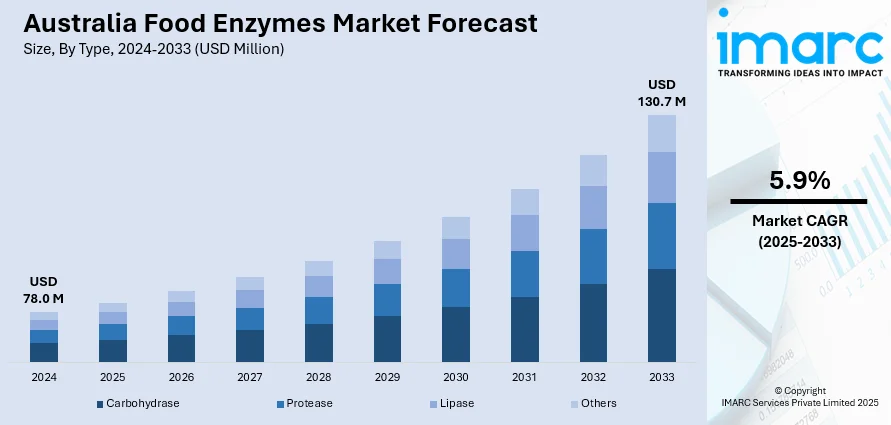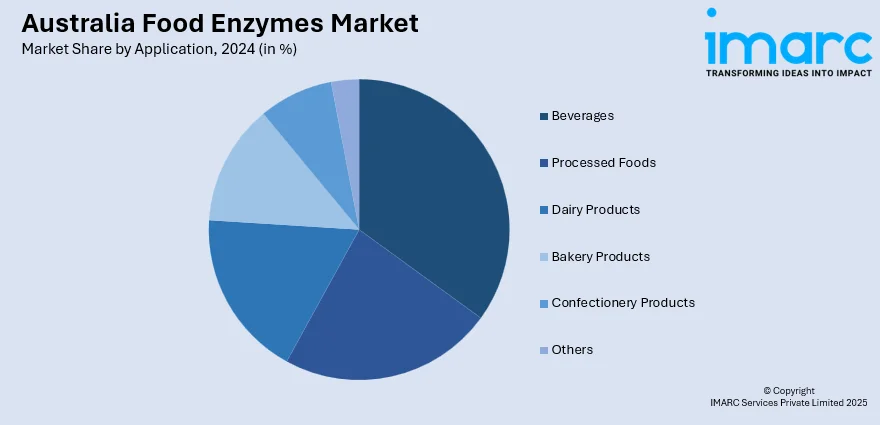
Australia Food Enzymes Market Size, Share, Trends and Forecast by Type, Source, Formulation, Application, and Region, 2025-2033
Australia Food Enzymes Market Overview:
The Australia food enzymes market size reached USD 78.0 Million in 2024. Looking forward, IMARC Group expects the market to reach USD 130.7 Million by 2033, exhibiting a growth rate (CAGR) of 5.9% during 2025-2033. The market share in Australia is expanding, driven by the escalating demand for convenience and processed food products among the masses, shaped by advances in biotechnology and genetic engineering, and expanding awareness about the value of functional foods and ingredients.
|
Report Attribute
|
Key Statistics
|
|---|---|
|
Base Year
|
2024
|
|
Forecast Years
|
2025-2033
|
|
Historical Years
|
2019-2024
|
| Market Size in 2024 | USD 78.0 Million |
| Market Forecast in 2033 | USD 130.7 Million |
| Market Growth Rate 2025-2033 | 5.9% |
Australia Food Enzymes Market Trends:
Increasing Demand for Processed and Convenience Foods
The rising demand for convenience and processed food products in Australia is impelling the growth of the market. With consumers looking for products that provide convenience without sacrificing quality, manufacturers are increasingly turning to food enzymes to improve the texture, flavor, shelf-life, and nutritional value of products. Enzymes are used extensively in the manufacture of bakery items, dairy items, beverages, and meat processing to enhance consistency and performance. With an increase in dual-income households and the fast-paced nature of Australian consumers, there is a rise in the demand for pre-packaged and ready-to-eat meals, thus creating the need for enzymes used to preserve the product and improve flavor. This change in the way consumers purchase is propelling enzyme use, leading suppliers to create customized enzyme solutions to suit the changing needs of the food sector. The IMARC Group predicts that the Australia food processing market size is expected to reach USD 187.60 Billion by 2033.

To get more information on this market, Request Sample
Technological Advancements in Enzyme Production
Technological enhancements in food production and use of food enzymes are contributing to the Australia food enzymes market growth. Enzyme manufacturing is shaped by advances in biotechnology and genetic engineering that are resulting in more effective and less expensive enzymes. These advancements are making enzymes more accessible to food manufacturers by reducing production costs, increasing enzyme stability, and improving their performance under different processing conditions. Besides this, enzyme optimization research is making it possible for more precise targeting of processes, such as fermentation, protein degradation, and starch hydrolysis. These advancements are creating wider possibilities for applications across different segments of the food processing industry, further driving enzymes' use. As Australian food manufacturers aim for enhanced operational efficiency and product quality, the possibility to tap into sophisticated enzymatic solutions is making a critical contribution to the market growth.
Growing Focus on Health and Wellness
The rising consumer interest in health and wellness is offering a favorable Australia food enzymes market outlook. With an expanding awareness about the value of functional foods and ingredients, enzymes are being increasingly appreciated for their contribution to improving the nutritional value of foods. Enzymes like amylases, proteases, and lipases are employed to enhance the digestibility of food and enhance the availability of nutrients such as proteins, vitamins, and minerals. Enzymes can also be employed to decrease the sugar and fat content in food, which is in accordance with the increasing need for healthier options. As Australian consumers keep healthy eating in their preferences, food manufacturers are adding enzymes to suit such needs by enriching the nutritional quality and functional properties of foods. The IMARC Group stated that the Australia health and wellness market size is expected to exhibit a growth rate (CAGR) of 6.75% during 2025-2033.
Australia Food Enzymes Market Segmentation:
IMARC Group provides an analysis of the key trends in each segment of the market, along with forecasts at the country and regional levels for 2025-2033. Our report has categorized the market based on type, source, formulation, and application.
Type Insights:
- Carbohydrase
- Amylase
- Cellulase
- Lactase
- Pectinase
- Others
- Protease
- Lipase
- Others
The report has provided a detailed breakup and analysis of the market based on the type. This includes carbohydrase (amylase, cellulase, lactase, pectinase, and others), protease, lipase, and others.
Source Insights:
- Microorganisms
- Plants
- Animals
A detailed breakup and analysis of the market based on the source have also been provided in the report. This includes microorganisms, plants, and animals.
Formulation Insights:
- Powder
- Liquid
- Others
A detailed breakup and analysis of the market based on the formulation have also been provided in the report. This includes powder, liquid, and others.
Application Insights:

- Beverages
- Processed Foods
- Dairy Products
- Bakery Products
- Confectionery Products
- Others
A detailed breakup and analysis of the market based on the application have also been provided in the report. This includes beverages, processed foods, dairy products, bakery products, confectionery products, and others.
Regional Insights:
- Australia Capital Territory & New South Wales
- Victoria & Tasmania
- Queensland
- Northern Territory & Southern Australia
- Western Australia
The report has also provided a comprehensive analysis of all the major regional markets, which include Australia Capital Territory & New South Wales, Victoria & Tasmania, Queensland, Northern territory & Southern Australia, and Western Australia.
Competitive Landscape:
The market research report has also provided a comprehensive analysis of the competitive landscape. Competitive analysis such as market structure, key player positioning, top winning strategies, competitive dashboard, and company evaluation quadrant has been covered in the report. Also, detailed profiles of all major companies have been provided.
Australia Food Enzymes Market Report Coverage:
| Report Features | Details |
|---|---|
| Base Year of the Analysis | 2024 |
| Historical Period | 2019-2024 |
| Forecast Period | 2025-2033 |
| Units | Million USD |
| Scope of the Report |
Exploration of Historical Trends and Market Outlook, Industry Catalysts and Challenges, Segment-Wise Historical and Future Market Assessment:
|
| Types Covered |
|
| Sources Covered | Microorganisms, Plants, Animals |
| Formulations Covered | Powder, Liquid, Others |
| Applications Covered | Beverages, Processed Foods, Dairy Products, Bakery Products, Confectionery Products, Others |
| Regions Covered | Australia Capital Territory & New South Wales, Victoria & Tasmania, Queensland, Northern territory & Southern Australia, Western Australia |
| Customization Scope | 10% Free Customization |
| Post-Sale Analyst Support | 10-12 Weeks |
| Delivery Format | PDF and Excel through Email (We can also provide the editable version of the report in PPT/Word format on special request) |
Key Questions Answered in This Report:
- How has the Australia food enzymes market performed so far and how will it perform in the coming years?
- What is the breakup of the Australia food enzymes market on the basis of type?
- What is the breakup of the Australia food enzymes market on the basis of source?
- What is the breakup of the Australia food enzymes market on the basis of formulation?
- What is the breakup of the Australia food enzymes market on the basis of application?
- What is the breakup of the Australia food enzymes market on the basis of region?
- What are the various stages in the value chain of the Australia food enzymes market?
- What are the key driving factors and challenges in the Australia food enzymes?
- What is the structure of the Australia food enzymes market and who are the key players?
- What is the degree of competition in the Australia food enzymes market?
Key Benefits for Stakeholders:
- IMARC’s industry report offers a comprehensive quantitative analysis of various market segments, historical and current market trends, Australia food enzymes market forecasts, and dynamics of the market from 2019-2033.
- The research report provides the latest information on the market drivers, challenges, and opportunities in the Australia food enzymes market.
- Porter's five forces analysis assist stakeholders in assessing the impact of new entrants, competitive rivalry, supplier power, buyer power, and the threat of substitution. It helps stakeholders to analyze the level of competition within the Australia food enzymes industry and its attractiveness.
- Competitive landscape allows stakeholders to understand their competitive environment and provides an insight into the current positions of key players in the market.
Need more help?
- Speak to our experienced analysts for insights on the current market scenarios.
- Include additional segments and countries to customize the report as per your requirement.
- Gain an unparalleled competitive advantage in your domain by understanding how to utilize the report and positively impacting your operations and revenue.
- For further assistance, please connect with our analysts.
 Request Customization
Request Customization
 Speak to an Analyst
Speak to an Analyst
 Request Brochure
Request Brochure
 Inquire Before Buying
Inquire Before Buying




.webp)




.webp)












